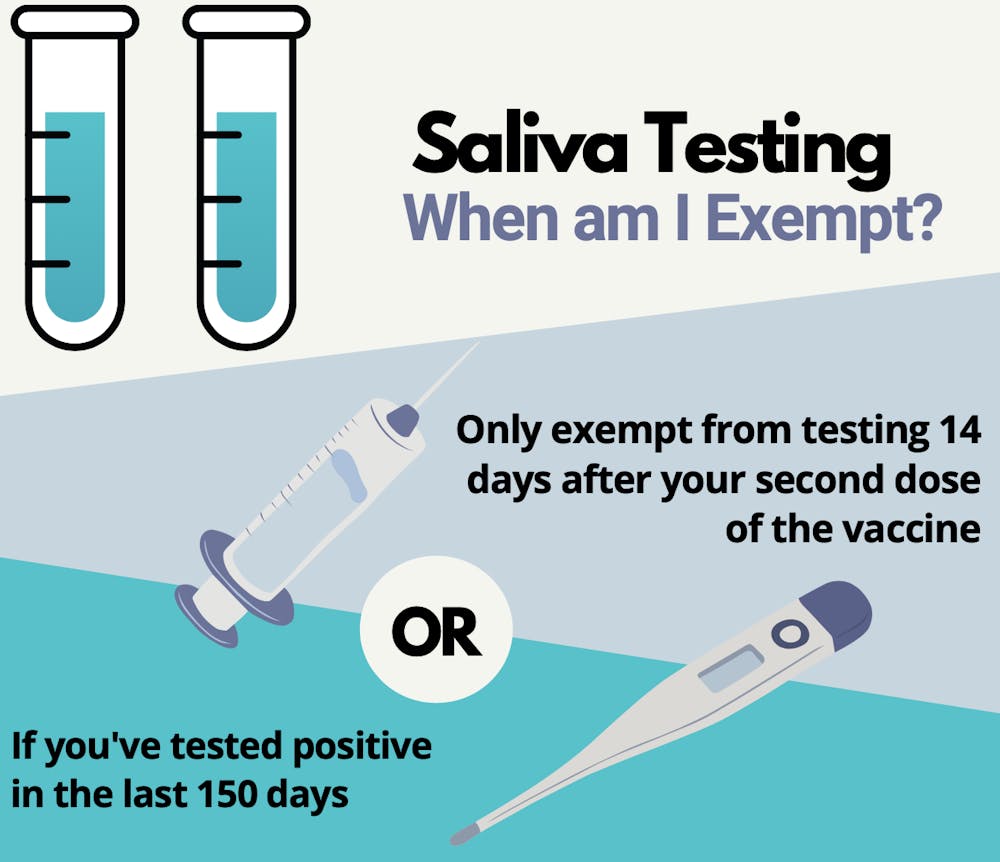COVID-19 prevalence testing numbers have decreased but not due to lack of compliance with University protocol, according to University spokesperson Brian Coy. Rather, the increased availability of vaccines has allowed many students to forgo their weekly testing appointments, which they are eligible to do two weeks after their final vaccine dose.
The spring semester has seen a more regulated system of prevalence testing than the fall as all students living in the Charlottesville-Albemarle area now are required to participate in weekly saliva testing with assigned appointment locations and times. Locations include the Central Grounds Parking Garage, Scott Stadium, The Park at North Ground and the Health Sciences Library.
During the fall, students living off-Grounds were randomly selected for asymptomatic prevalence testing two to three times, while students living on-Grounds were tested at least once every nine days as part of a requirement implemented in October. The seven-day average number of tests peaked at 1,365 in November during the fall semester, compared to a peak seven-day average of 2,528 cases in February of the spring semester.
According to an email sent to students on Jan. 28 from Provost Liz Magill, Chief Operating Officer J.J. Davis and Department of Medicine Chair Dr. Mitch Rosner, there are consequences for missing a prevalence test — on the first violation, a student receives a warning, on the second a notification is sent to the student’s school, on the third students lose access to University resources and on the fourth the student faces an interim disciplinary suspension.
The University announced the availability of COVID-19 vaccines for students in an email from Dean of Students Allen Groves on April 9. Students started to receive emails April 12 with an invitation to make an appointment at the U.Va. Health Community Vaccination Center in the Seminole Square Shopping Center. Currently, Pfizer and Moderna vaccinations are being offered through U.Va. Health, but students will not know which vaccine they will receive until after arriving at their appointment.
While students begin to get vaccinated, weekly prevalence testing for COVID-19 will still continue for many students. Students are exempt from prevalence testing 14 days after their final dose of a COVID-19 vaccine or within the 150 days following a positive test result.
According to Eric Swensen, public relations officer for U.Va Health, the U.Va. Health vaccination team estimates that about 4,100 University students and about 1,000 University faculty have signed up to receive vaccinations as of April 19. These numbers do not reflect the students that were vaccinated outside of the University.
Coy said that students’ compliance with prevalence testing has remained consistent with between 91 percent and 93 percent participation. The increase in vaccinations and the presence of students who have tested positive in the last 150 days are responsible for the decreasing number of students who are required to comply with weekly prevalence testing guidelines. The current seven-day average number of student COVID-19 tests is 1,663 tests per day, compared to a seven-day average of 1,813 a month earlier.
First-year College student Izzy Araojo received the Johnson & Johnson COVID-19 vaccine in mid-March after qualifying in a priority group in Virginia. Araojo expressed that for the fall and spring semesters her attitude toward the pandemic has remained the same, and even after being fully vaccinated, she has remained cautious and careful.
“You know, I'd like to have a normal first year and go out to parties and stuff like that, but I'd rather be safe,” Araojo said.
For the rest of this school year, Araojo plans to continue her precautions including wearing a mask and social distancing. However, for two weeks now, she has been exempt from prevalence testing.
While Araojo remains consistent in following COVID-19 guidelines, she does see how some students may take the vaccine as an opportunity to change their behavior.
“They may feel like it's safe for them to go out and do things and not wear their masks as much, but I haven't seen anything personally,” Araojo said.
First-year College student Emily Andrews — who received her first of two vaccine doses April 12 through the state of Virginia after qualifying through her job as a lifeguard — expressed a similar sentiment as Araojo. Before and after her vaccination, Andrews has remained conscientious about guidelines in order to protect herself and her family.
Andrews has not been exempt from prevalence testing yet because she has only received one dose and continues to wear a mask and practice social distancing.
“I'm aware that I can still get [COVID-19], there's still a good chance that I can get it with the first shot and everything,” Andrews said. “So I've been pretty careful.”
Based on clinical trials, the Pfizer-BioNTech vaccine is 95 percent effective in preventing COVID-19 in individuals aged 16 years or older without prior infection, while the Moderna vaccine is 94.1 percent effective for individuals 18 years or older. According to William Petri, chief of the Division of Infectious Diseases and International Health at the University, the second dose of each vaccine increases protection from 60 percent after the first dose to approximately 95 percent.
After being fully vaccinated, Andrews is looking forward to interacting with others who have also been fully vaccinated against COVID-19.
“I'm excited to see all my friends that I haven't seen in a while and get back to working in a more normal environment,” Andrews said.
After getting vaccinated, students still need to comply with all University public health guidelines, which currently include an indoor gathering limit of 25 individuals and an outdoor gathering limit of 75 individuals. Regardless of the gathering size, all students must continue to remain at least six feet apart and wear a mask when around others.







